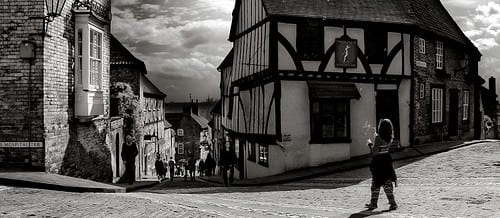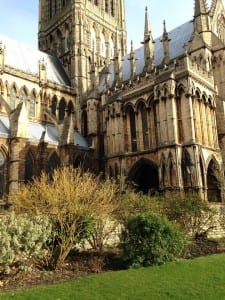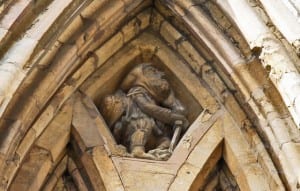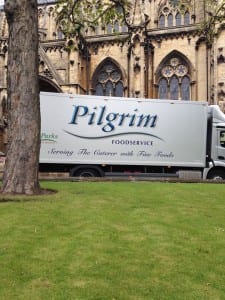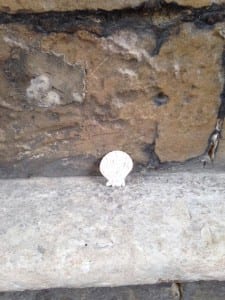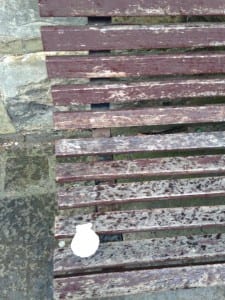Framing Statement
“All precious things, discovered late” was a site specific audio tour around the outside of Lincoln Cathedral which explored the themes of journey and pilgrimage, created and performed by Fleur Kenneally, Jess Martin, Charlotte Roberts and I. We chose to work at this site because we felt it was a fairly unknown area to most people, including us, and wanted to create a piece where our audience could discover and learn more about a site.
The performance began on the 6th of May, 2015, at 11:00, and lasted half an hour, with the tour starting and ending for each individual within that time. The piece started on the green near the Judgement Doors, where the audience were greeted by us, the performers, and offered a scallop shell. They were then asked to walk to the Judgement Doors and press play on the first audio, in which they were spoken to and taken around the rest of the tour through our recording. We placed scallop shells and audio connecting objects around the site to emotionally connect and enhance the audio as the audience listened. When they returned back to the green at the end, we asked them questions to reflect upon their experience within the piece.
Our invited audience were predominately fellow drama university students, though anyone was able to download the audio for the piece on the day, as well as for the future. The audiences’ role in the piece was to listen to and experience the audio on the tour, hopefully discovering the site in a creative way for the first time or from a new perspective.
We were predominately influenced by Proto-type Theatre’s “Fortnight”, along with Robert Wilson who inspired the style of the tours walk, and Adrian Howels and Lemm Sissay whom inspired the way we recorded and produced the audio. I was influenced primarily by Mike Pearson in my reading over the course of our development process.
In all, our overall aim for our piece was to have the site, the audio and our audience all working together to create the performance as one. We wanted the site to be at the heart of our work, and as such, be the “performer” for our audience.
The Beginning Process
Site specific performance is referred to by Patrice Pavis as “a place in the real world” (Pavis, 1998, 337-338). This definition was my inspiration to first begin to explore creating a piece using the Cathedral and its surrounding area as a site, and as Peter Brook said, “take any empty space and call it a bare stage” (Brook, 1972, 11). When I initially walked around the area, I was struck by how the Cathedral was at the heart and height of the city, both literally and metaphorically, and thought a performance using the building would be interesting to make. From my exploration of the area, through creating text fragmentations, unconventional maps and misguided tours, I was inspired to think of the site imaginatively and playfully. Fleur, Jess, Charlotte and I found we had a shared interest in the Cathedral, and in creating a performance where the audience’s experience was at its core, and thus decided to become a group.
The Initial Idea
Our group was intrigued by how different individuals see the Cathedral in a different light, from those who first built the Cathedral, to those who grew up around the site, to the visitors seeing it for the first time. The relationship between an individual and the Cathedral, and that differentiation for each person, was the basis of our idea. We watched how children experienced the Cathedral, both inside and around the area, and began our process with the hope of making an audio tour of children telling stories and perspectives of the Cathedral. We wanted to ask our audience to put themselves into the mind of a child and see the site through a playful experience. Moreover, we learnt that there was a statue of Alfred Lord Tennyson at the back of the Cathedral, which we believed was unknown to many visitors to the area. We wanted to use his poem “Cradle Song” within the audio, recorded by a child, to include the statue within our tour and enhance our theme of childhood.
I looked at other audio-based performances, such as Robert Wilson’s “Walking”, and was interested in how he had made an immersive audience experience. As such, we initially thought we needed to be overtly creative with our site through audience interaction to literally show the differing perspectives. One idea was to ask our audience to write their own perspectives down on paper and pin them on to bunting, which we would hang around the site.
As Fiona Wilkie says, “site-specific performance engages with site as symbol, site as story-teller, site as structure” (Wilkie, 2002, 150), and we decided to interview and record local shop-keepers about their thoughts of the Cathedral to acquire the numerous perspectives we needed. We believed those who were near the Cathedral everyday would have a strong affiliation with our site. For example, we asked them “how would you describe this (a photograph of some architecture) to a tourist if you were conducting a tour?” We were able to learn more about how others saw the site, as Mike Pearson also experienced when he said that “these differentiated places act as “containers” (of memories, stories and legends)” (Pearson, 2010, 55).
In hindsight, whilst our original idea did have our audience at its centre, we were manipulating the way they thought of the site, instead of allowing for their own personal perspective to form and possibly change on their own.
The Final Idea and Development
Mike Pearson says that “there is no privilege of origin: a place owes its character not only to the experiences it affords as sights, sounds, etc. but also to what is done there as looking, listening, moving” (Pearson, 2010, 16). After discussing how vast the history of the site was, we became interested in the idea of a pilgrimage, a journey made to a sacred place as an act of religious devotion, which many have embarked upon to the Cathedral. Our piece developed into an audio tour based on the idea of a “journey”, both physically and mentally for our audience. As Mike Pearson suggests, “both “being” and environment are mutually emergent, continuously brought into existence together” (Pearson, 2010, 16), and this development allowed us to continue to explore such a relationship. Unknown to us before, there is an image of a pilgrim on the Cathedral, situated close to where we were beginning our tour, a coincidence that excited us to further this idea.
Though we did not want out tour to be overtly about or based upon any religious or historical material, we wanted to use a pilgrimage as a means of our audience to explore the site. We decided to use a scallop shell, an associated symbol of a pilgrimage, to be the symbol of our tour. We wanted to ask our audience at the beginning to take a scallop shell as a gift and physical representation of their acceptance to the journey they were about to go on. As Jen Harvie believes, site specific performance should be used “to explore spatial and material histories to mediate the complex identities these histories remember and produce” (Harvie, 2005, 44), and similarly we wanted to reference the previous use of the Cathedral, as a place for a pilgrimage, whilst having its present community, our audience, discover it.
Once we had the basis of our performance, we spent several weeks improving our piece. By having someone else listen to and experience our developing idea, such as Rachel who we met with regularly, our piece was able to grow. We began our development stage by aiming for our tour to be simple in its design, removing all the extra aspects we had previously felt the need to include. As David Wiles infers, “the play-as-event belongs to the spaces, and makes the space perform as much as it makes actors perform” (Wiles, 2003, 1), which I think surmises how we needed to let the Cathedral “perform” on its own. As such, we decided that our roles within the tour would be small so that we were not the focus. The first significant inclusion into the tour was the subtle moments of coincidence for the audience to experience, which kept the “playfulness” to the tour with “gifts” for them to find. Our ideas for this included having two people playing cat’s cradle, the sound of birds heard within the recording and the offering of refreshments to the audience. The second important inclusion was the use of Shakespeare’s speech “All the worlds a stage…” from As You Like It, read out by an elderly gentleman.
“All the worlds a stage…” Recording. (Kenneally, F, Langer, M, Martin, J and Robert, C, 2015)
We felt this speech represented the theme of journey that was already present in our performance. Additionally, we built on this connection by expanding the tour to cover the entire surrounding of the Cathedral to end full circle back at the green we started on, placing small objects and audio sounds that related to the differing stages throughout the tour. We hoped that by the end of the tour the audience felt changed by their experience in how they saw the Cathedral, having gone on their own personal journey around the site.
These inclusions helped the piece move onwards, as Miwon Kwon believes, “from a physical location – grounded, fixed, actual – to a discursive vector – ungrounded, fluid, virtual” (Kwon, 2004, 3), and gave our tour a metaphorical and poetic layer for our audience.
By changing how the audience experiences the space through the performance, we hoped the theme of a life journey would be prominent to the audience. Our biggest inspiration within the entire process came from Proto-type Theatre’s “Fortnight”, and how their performance was based upon “the ever-mutating process of taking on new perspectives and interacting in the city…” (Hui, 2011, 8). Although ours would be a much smaller experience in terms of space and time, we still hoped to emulate the playfulness of their piece in showing their site to their audience, putting their experience at the forefront.
Once we were certain that we had developed our idea to its fullest, we moved onwards to record the audio tour and rehearse with it within the site.
The First Audio Recording
We all understood the importance of our audio being descriptive and directional to tour the audience around the site on its own, whilst also being enjoyable. We scripted what we felt needed to be heard on the audio, focusing on every sentence to be certain of its clarity.
After a draft performance in the site, Rachel advised that we work on the timing of the tour and the length of pauses, to enable our audience to walk around the site at a comfortable pace. Additionally, Rachel also recommended we adjust the tone of our audio, making it seem as if we were a companion to the audience to build a relationship between us, the recorded voice, and the individual, making it a more welcoming experience. For example, we needed to use words like “I” and “we” to express our own thoughts of the site, which would allow for audience reflection to occur naturally. Like Fiona Wilkie, we felt that “it’s not just about a place, but the people who normally inhabit and use that place…” (Wilkie, 2002, 145), and that the audience’s experience was central.
The Second Audio Recording
As a consequence, we re-recorded the audio with the objective for it to be conversational. To do this, we recorded and created a transcription of the meeting where we scripted the new audio, naturally allowing for it to sound conversational, and helping us to understand what the audience would hear when we recorded the final version.
We were further influenced through the “Every day moments” podcasts of Adrian Howels and Lemm Sissay. Both used aspects in their audio that we wanted to emulate, such as background noises to enhance an emotional thought for the audience, and simplistic language to effectively portray our directions for the audience.
We again had a draft performance with Rachel, as well as another student on the module whom had no previous knowledge of our work. Both suggested we work on the directions and pauses further, and amend a few of the formal words we used, but overall were very positive about the audio. Similarly to Paul Allain and Jen Harvie, we wanted “to alter the conventional spatial practices of performance to enhance both the relationship between performers and audience and the performance’s engagement with its space and site of production” (Allain and Harvie, 2005, 148), a statement which I feel reflects what we hoped we had achieved through our development.
The Dress Rehearsal
For the dress rehearsal, we wanted to show Rachel a near-perfect example of our final performance, including:
- the introductory speech
- the final recording of the audio
- the subtle moments of coincidence and scallop shells
- our role as performers within the tour
Prior to the rehearsal, we finalised all of the coincidental moments, which included the sounds on the audio of birds, a child’s “lost” bag and confetti to be scattered at the Minster Yard corner. We bought one hundred scallop shells to make necklaces out of for our audience to accept as their gift of the tour, and planted the rest around the space for our audience to find. Furthermore, we recorded the audio again for a final time with the small changes previously suggested to us. Within the piece, Jess and I began the tour with an introductory welcome, and asking our audience, Rachel, to take a scallop shell necklace as a sign of their acceptance to the tour. Once they began listening to the audio, Charlotte offered refreshments at the Tennyson statue and Fleur was within Castle Square to oversee. We received positive feedback of the final rehearsal, as well as smaller details Rachel suggest we look over for the final recording.
“The First Audio” Final Recording. (Kenneally, F, Langer, M, Martin, J and Robert, C, 2015)
Overall, the dress rehearsal confirmed to us, like Fortnight, that we could define our piece as “part theatrical magic, part philosophical treasure hunt”. (Proto-type, 2015)
Marketing The Performance
We entitled our performance a quote from Tennyson’s “The Daydream”, “all precious things, discovered late”, as we felt the idea of discovery captured our tours purpose, of discovering more about the Cathedral and an inner discovery for the individual. We created a public event prior to the day and invited potential audience members.
https://www.facebook.com/events/729015657221978/
We published the audio to the event on the 4th of May, and asked those certain of their attendance to download the audio on to their own devices. We asked them to meet us at the green near the Judgement Doors at 11:00 on the 6th of May, where we would introduce the piece and ask them to begin the tour.
Performance Evaluation
Unfortunately, we had extremely bad weather on the performance day, and consequently, had a small audience of a couple of people. However, because of individualised nature of the audio tour, the number of the audience had no bearing on the piece. Once the audience arrived at the green, after having downloaded the audio through the event page, we introduced the tour and offered them a scallop shell. They then walked over to the Judgement Doors and began listening to the audio. As performers, we remained in our roles from the dress rehearsal. Once the tour had ended for each individual and they returned to the green, we asked them questions to help them reflect upon their experience and to allow us to gain feedback.
All said they had a positive experience, and all commented that their favourite aspect of the tour was finding the scallop shells and moments of coincidence, such as the sounds on the audio itself or a visual prop that we had placed across the piece. We hoped these would enhance an emotional response for the audience, as well as making the tour a creative and pleasant experience. We placed the physical objects where the audience could potentially see them, with the knowledge that they did not have to be noticed by everyone, but instead only as an opportunity for coincidence if a link between the two was made. Additionally, we were told that they had all noticed more moments that we had not planned, such as a robin tweeting, a man walking his dog, and a van with the word “pilgrim” parked near the green. These were true moments of chance, which added a pure connection to our audio that was there solely on the day.
For the future, the audio tour can be performed again at any time. Though the moments of coincidence that we had physically placed on the day would not be available, I believe this would not diminish the experience entirely. Furthermore, as we ourselves found, true moments of coincidence can occur in performance, making it that much more serendipitous. Whilst the piece would probably be better experienced on a “nicer” day, this is not something that anyone can truly plan for, and as we found, the conditions of an outside performance does not have a vast impact on a piece. Henceforth, our work can continue on after and without us.
Overall, I feel our performance and the progress we made as a group from when we started to the final day was a success. I feel we all embraced what site specific performance can be, and made something that reflected what we all wanted to make at the beginning. Our piece had the Cathedral at the core, and hopefully enabled our audience to discover and learn more about the site and themselves, through a physical and metaphorical journey. As Mike Pearson suggests, our work may “become a lasting part of the story of that place” (Pearson, 2010, 16), offering a larger purpose for the hard work and time we put into the module. This module has impacted how I define a “performance”, and shown me another aspect of drama that I had no previous concept of, enabling me to have grown as a performer.
Allain, P and Harvie, J. (2005) The Routledge Companion to Theatre and Performance. London: Routledge.
Brook, P. (1972) The Empty Space. London: Penguin Books.
Hannah-Briggs, J. (2013) The Lincoln Pilgrim, Lincoln Cathedral. [online] Available from http://www.geograph.org.uk/photo/3409318 [Accessed 18 April 2015].
Harvie, J. (2005) Staging the UK. Manchester: Manchester University Press.
Hui, Allison. (2011) Art as an everyday intervention: shifting times, places and mobilities in the pervasive media performance project “Fortnight”. Hong Kong: Hong Kong Baptist University.
Kenneally, F, Langer, M, Martin, J and Robert, C. (2015) All precious things, discovered late. [performance] Fleur Kenneally, Megan Langer, Jess Martin and Charlotte Roberts. (dir.) Lincoln: Lincoln Cathedral, 7 May.
Kwon, M. (2004) One Place After Another. Cambridge: MIT Press.
Pavis, P. (1998) Dictionary of the Theatre: Terms, Concepts, and Analysis. Toronto: University of Toronto Press.
Pearson, M. (2010) Site-Specific Performance. Hampshire: Palgrave Macmillan.
Proto-type. (2015) Fortnight. [online] Available from http://proto-type.org/projects/current/fortnight/ [Accessed 13 May 2015].
Wiles, D. (2003) A Short History of Western Performance Space. Cambridge: Cambridge University Press.
Wilkie, F. (2002) Mapping the Terrain: a Survey of Site-specific Performance in Britain. Cambridge: Cambridge University Press.
